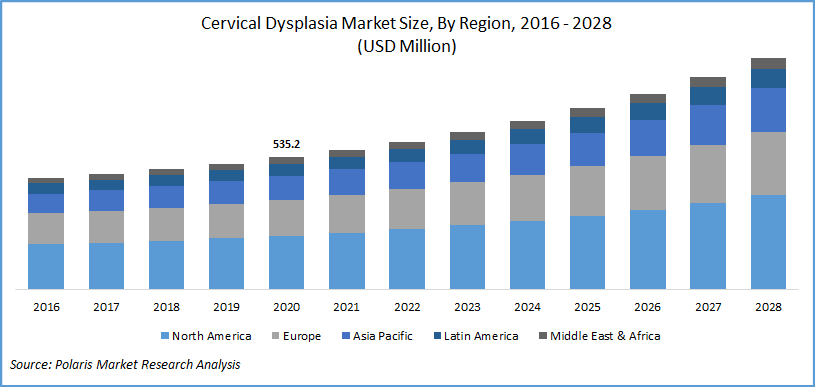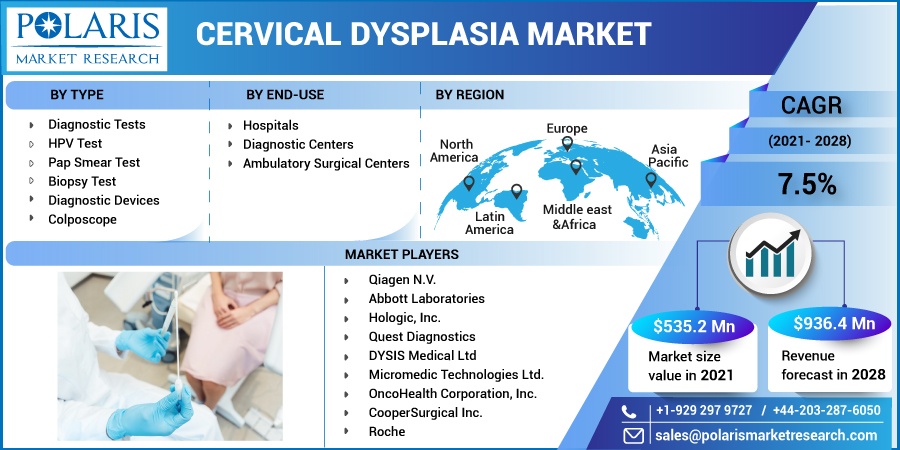
Cervical Dysplasia Market Share, Size, Trends, Industry Analysis Report, By Type (Diagnostic Tests, {HPV Test, Pap Smear Test, Biopsy Test}, Diagnostic Devices, Colposcope); By End-Use (Hospitals, Diagnostic Centers, Ambulatory Surgical Centers), By Regions; Segment Forecast, 2021 - 2028
- Published Date:Feb-2021
- Pages: 108
- Format: PDF
- Report ID: PM1807
- Base Year: 2020
- Historical Data: 2016 - 2019
Report Outlook
The global cervical dysplasia market was valued at USD 535.2 million in 2020 and is expected to grow at a CAGR of 7.5% during the forecast period. Cervical dysplasia is an abnormal condition in which normal cells in the cervix region undergo abnormal changes. Cervix is the bottom part of the uterus, which finally leads into the vagina. This is the one, which dilates during childbirth, through which the fetus passes. In this condition, abnormal cells are not cancerous, but in later life, the stage could mutate into cancerous cells, if not treated or diagnosed on time. The Human Papillomavirus (HPV) is the main causal agent for cervical dysplasia.
The cervical dysplasia market report details key market dynamics to help industry players align their business strategies with current and future trends. It examines technological advances and breakthroughs in the industry and their impact on the market presence. Furthermore, a detailed regional analysis of the industry at the local, national, and global levels has been provided.
Rising incidence of cervical dysplasia, government-sponsored screening programs, and global vaccination programs are the prominent factors responsible for the market growth for cervical dysplasia. According to the study done by the Johns Hopkins University, each year in the U.S. alone cervical dysplasia affects around 1 million women in the age group of 25 to 35. However, its incidence is decreasing with the rising use of the HPV vaccine. It is being estimated that one type of HPV has declined in younger women in the U.S., by over 60 percent.

Know more about this report: request for sample pages
Industry Dynamics
Growth Drivers
Cervical dysplasia market growth is catalyzed by an increase in the number of government-funded screening programs, to spread awareness regarding the ill impacts of the concerned indication. For instance, in 2019, Public Health England (PHE) introduced the first-ever government-sponsored awareness campaign about the smear tests used in cervical dysplasia. It is also mentioned that women aged 25 years or more, who undergo smear tests are the lowest in the past two decades, owing to fear and embarrassment associated with it.

Know more about this report: request for sample pages
In 2018, NHS has reported that the percentage of women who were screened stood at 71.4 percent. The campaign involved collaborations between social media sites and media channels to spread a positive narrative of the smear tests. Thus, the rise in government-sponsored campaigns about cervical dysplasia is likely to boost the market growth in the coming future.
Cervical Dysplasia Market Report Scope
The market is primarily segmented on the basis of type, end-use, and region.
|
By Type |
By End-Use |
By Region |
|
|
|
Know more about this report: request for sample pages
Insight by Type
In 2020, the diagnostic tests market segment held the largest revenue share of the market for cervical dysplasia, among all. The factors responsible for this include positive reimbursement scenario, high efficacy, and cost-effectiveness. Its low cost resulted in higher penetration in emerging countries. Moreover, strong government initiatives also boosted the adoption of PAP smear tests. For instance, in 2017, the New Zealand government introduced “Smear your Mea”. This had encouraged women to do smear tests to prevent future occurrences of the concerned condition.
The colposcope market segment is projected to witness the highest growth rate of the market for cervical dysplasia over the assessment period. This future growth is attributed to the realizations in collaboration between market players. For instance, in March 2016, DYSIS Medical entered into an agreement with ITEM Medical Technologies to support the National Screening Programme for Turkish women in association with the Turkish Ministry of Health. Under this, the former company provided Colposcope cervical cancer screening. Thus, such growing initiatives are expected to benefit the market for cervical dysplasia in the near future.
Insight by End-Use
In 2020, the hospital market segment accounted for the largest share of the global cervical dysplasia market. This high share is attributed to the high affordability and spending capacity of hospitals. Moreover, the presence of favorable reimbursement scenarios and the emergence of specialty hospitals, which are better equipped with advanced devices also contributing to the cervical dysplasia industry segment’s growth prospects.
Several hospitals in the developing region are undertaking various initiatives to carry out an early diagnosis. For instance, in May 2019, Provincial Health Services Authority collaborated with several family doctors in the Surrey area of the UK to connect with women for routine screening in rural areas.
Geographic Overview
Geographically, the global market for cervical dysplasia is bifurcated into North America, Asia Pacific, Europe, Latin America, and MEA. North America is the largest revenue contributor followed by Europe and the Asia Pacific region. In 2019, the North America region accounted for over 40% percent of the global market for cervical dysplasia.
North America is poised to maintain its dominance over the assessment period on the global market for cervical dysplasia. Regional factors boosting the market growth of cervical dysplasia include government-sponsored screening programs, a rise in the prevalence of associated diseases, and support initiatives for the adoption of HPV testing.
For instance, in December 2018, Nurx, a U.S.-based start-up introduced direct-to-consumer HPV testing kits. This is free, covered with insurance, and facilitates the detection of 14 HPV genotypes. The company’s target customers include women living in rural areas without any insurance and require compulsory tests.
Competitive Insight
The prominent players operating in the marketplace are Qiagen N.V., Abbott Laboratories, Hologic, Inc., Quest Diagnostics, DYSIS Medical Ltd, Micromedic Technologies Ltd., OncoHealth Corporation, Inc., CooperSurgical Inc., and Roche.
In today’s hyper-connected world, running a business around the clock is no longer an option. And at Polaris Market Research, we get that. Our sales & analyst team is available 24x5 to assist you. Get all your queries and questions answered about the cervical dysplasia market report with a phone call or email, as and when needed.
